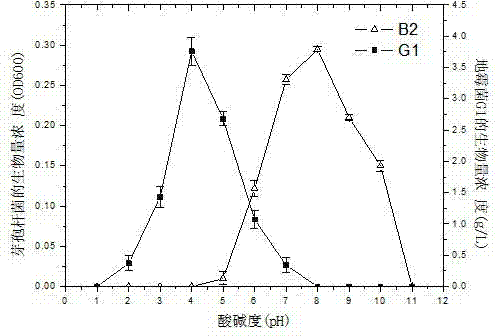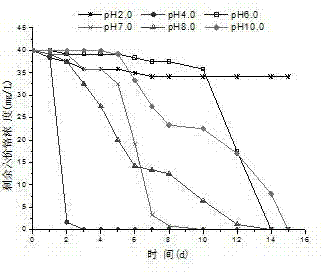Method for processing hexavalent chromium pollution employing synergistic effects of mixed bacteria
A technology of synergy and compound strains, applied in the field of environmental bioengineering, to achieve the effects of improving governance effects, improving treatment efficiency, and increasing tolerance range
- Summary
- Abstract
- Description
- Claims
- Application Information
AI Technical Summary
Problems solved by technology
Method used
Image
Examples
Embodiment 1
[0033] Acclimatization screening steps:
[0034] (1) Take 10 g of chromium-contaminated soil sample and add it to 100 ml of beef extract-peptone liquid medium, and incubate at 30°C for 24 h with a shaker speed of 120 rpm;
[0035] (2) Take 1 ml of the culture solution in step (1) and transfer it into 100 ml of inorganic salt liquid medium. The medium contains 20 mg / L of hexavalent chromium, prepared with potassium dichromate, and cultured at 30°C for 24 hours. Shaker speed is 120 rpm;
[0036] (3) Take 1 ml of the culture solution in step (2) and transfer it to 100 ml of inorganic salt liquid medium. The medium contains 30 mg / L of hexavalent chromium, prepared with potassium dichromate, and cultured at 30°C for 24 hours. The rotation speed of the shaker was 120 rpm, and so on, and the rest of the conditions were kept constant. The content of hexavalent chromium was gradually increased in increments of 10 mg / L until the concentration of hexavalent chromium reached 50 mg / L. Aft...
Embodiment 2
[0045] Acclimatization screening steps:
[0046] (1) Take 10 g of chromium-contaminated soil sample and add it to 100 ml of beef extract-peptone liquid medium, and incubate at 30°C for 24 h with a shaker speed of 120 rpm;
[0047] (2) Take 1 ml of the culture solution in step (1) and transfer it into 100 ml of inorganic salt liquid medium. The medium contains 20 mg / L of hexavalent chromium, prepared with potassium dichromate, and cultured at 30°C for 24 hours. Shaker speed is 120 rpm;
[0048] (3) Take 1 ml of the culture solution in step (2) and transfer it to 100 ml of inorganic salt liquid medium. The medium contains 30 mg / L of hexavalent chromium, prepared with potassium dichromate, and cultured at 30°C for 24 hours. The rotation speed of the shaker was 120 rpm, and so on, and the rest of the conditions were kept constant. The content of hexavalent chromium was gradually increased in increments of 10 mg / L until the concentration of hexavalent chromium reached 50 mg / L. Aft...
Embodiment 3
[0057] Acclimatization screening steps:
[0058] (1) Take 10 g of chromium-contaminated soil sample and add it to 100 ml of beef extract-peptone liquid medium, and incubate at 30°C for 24 h with a shaker speed of 120 rpm;
[0059] (2) Take 1 ml of the culture solution in step (1) and transfer it into 100 ml of inorganic salt liquid medium. The medium contains 20 mg / L of hexavalent chromium, prepared with potassium dichromate, and cultured at 30°C for 24 hours. Shaker speed is 120 rpm;
[0060] (3) Take 1 ml of the culture solution in step (2) and transfer it to 100 ml of inorganic salt liquid medium. The medium contains 30 mg / L of hexavalent chromium, prepared with potassium dichromate, and cultured at 30°C for 24 hours. The rotation speed of the shaker was 120 rpm, and so on, and the rest of the conditions were kept constant. The content of hexavalent chromium was gradually increased in increments of 10 mg / L until the concentration of hexavalent chromium reached 50 mg / L. Aft...
PUM
 Login to View More
Login to View More Abstract
Description
Claims
Application Information
 Login to View More
Login to View More - R&D
- Intellectual Property
- Life Sciences
- Materials
- Tech Scout
- Unparalleled Data Quality
- Higher Quality Content
- 60% Fewer Hallucinations
Browse by: Latest US Patents, China's latest patents, Technical Efficacy Thesaurus, Application Domain, Technology Topic, Popular Technical Reports.
© 2025 PatSnap. All rights reserved.Legal|Privacy policy|Modern Slavery Act Transparency Statement|Sitemap|About US| Contact US: help@patsnap.com



